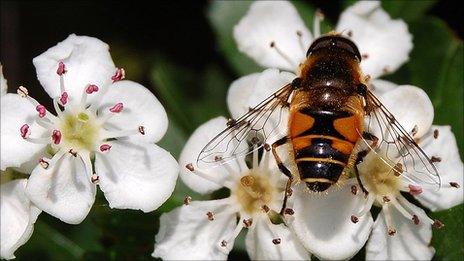Pollinators lured away by farmland, study shows
- Published

The researchers say their findings could be applied to habitats around the globe
A study has challenged the idea that areas such as farmland provide pollinating insects with a "corridor" between fragmented habitats.
Researchers suggested that the pollinators in their survey were "fickle foragers" and would concentrate on areas rich in pollen and nectar.
The team warned that these behaviour could have an impact on rare native plants that are pollinated by insects.
The findings have been published in the journal Current Biology, external.
The team of researchers from Oxford University and Earthwatch UK said their findings were a surprise, as the result challenged the long-held assumption that areas that were rich in resources would encourage the movement of pollinators from one group of native trees to another.
However, they added, it actually created a barrier effect for non-specialist feeders.
"Looked at from an insect's point of view, it makes sense," explained co-author David Boshier.
"These insects are not trying to pollinate a particular species of tree, they are just foraging. So if they leave a patch of native forest and fly across farmland which happens to be rich in resources, they are likely to collect pollen and nectar there rather than carry on to another patch of native forest."
However, Dr Boshier added: "Conversely, areas of sparse resources - such as (conifer) plantations - have less to offer so the pollinators are more likely to continue their journey and reach other patch of the native forest."
Pollination patterns
The researchers focused their attention on the pollination of Gomortega keule, an endangered species of tree whose natural stands only survive in patches of native forest in central Chile.

The study warns disruption to pollinators' behaviour could threaten Gomortega keule's long-term survival
The trees' primary pollinators are hoverflies. By sampling seeds, the team was able to develop an understanding of how pollen was transported across the study area.
"If you can imagine about 900 trees, and all of the potential connections between those trees, then you end up with a lot of data regarding where pollinators are moving or not moving," explained co-author Dr Tonya Lander.
"We used that data to build a model and, on average, these look like the patterns that are emerging," she told BBC News.
"In general, there was more pollination happening when trees are separated by tree plantations, and less pollination happening when the trees were separated by agricultural land."
The team explained that they decided to call this effect the Circe Principle, after a nymph in Homer's Odyssey who seduced Odysseus on his journey home from his adventures.
Another member of the team, Dan Bebber from Earthwatch, said: "This study shows that new landscape models need to take into account the positive contributions and benefits of landscapes defined as 'non-habitat', as well as how best they can be managed.
"Our results identify possible actions to improve the interactions of landscapes of endangered species such as G. keule, and other species pollinated by common insects."
The team now hope to carry out further studies to test whether the Circe Principle applies to other environments.
- Published28 September 2010